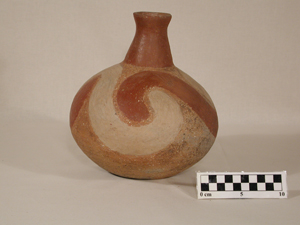How old is Arkansas rock art? In the past, rock art was notoriously difficult to date; the normal methods acheologists used to arrange their finds in relative order could not be applied. To some extent, subject matter provided clues. For example, an image of a mastodon would have to date to the late Pleistocene Paleo-Indian era, whereas an image of a man mounted on a horse and holding a rifle must date to the historic era, after horses and rifles were introduced by Europeans. Unfortunately, there are no mastodons in Arkansas rock art, and only one (very faded) horse pictograph that we know about. Though it is difficult to know the precise age of rock art, new research has given us better information to go on. The makers of a few historic inscriptions in Arkansas conveniently included a date with their work. The approximate ages of some American Indian rock art can be estimated by several methods: archeological association, stylistic comparison with other materials, and by use of direct dating techniques.
Stylistic Comparison. Rock art motifs and styles are sometimes duplicated on other materials. For example, some rock art designs at sites in Petit Jean State Park are also common decorations on fifteenth- and sixteenth-century ceramics from the
Direct Dating. Finally, a variety of dating techniques can be used to measure (directly or indirectly) the age of rock art images. Specialized techniques for radiocarbon dating, such as accelerated mass spectroscopy, can be used to determine the age of pigment samples collected from pictographs. Other techniques can determine the rate of growth of lichen and other kinds of coatings, such as biofilms and rock varnish, that sometimes develop on top of rock art. Dating these substances can provide a date before which the underlying rock art must have been produced. So far, none of these techniques has been used in Arkansas, but experiments have shown that pigment samples from Petit Jean contain material suitable for radiocarbon analysis. Mostly based on stylistic comparison with other decorated artifacts, and supported by the dates from The Narrows site, archeologists believe that most Arkansas rock art was made by American Indians during the Mississippian era (A.D. 900-1541). |
| Home | Quick Facts | Interpretations | Articles | Technical Papers | Resources | Database | Just For Kids | Picture Gallery | Buy the Book! |
|
Last Updated: April 5, 2007 at 3:54:42 PM Central Time
|


